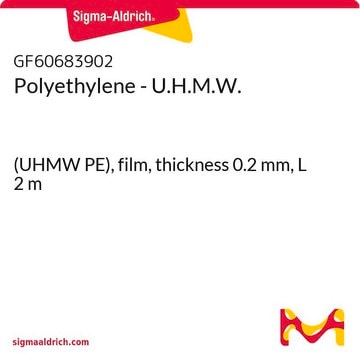If this product has an expiration or retest date, it will be shown on the Certificate of Analysis (COA, CofA). If there is no retest or expiration date listed on the product's COA, we do not have suitable stability data to determine a shelf life. For these products, the only date on the COA will be the release date; a retest, expiration, or use-by-date will not be displayed.
For all products, we recommend handling per defined conditions as printed in our product literature and website product descriptions. We recommend that products should be routinely inspected by customers to ensure they perform as expected.
For products without retest or expiration dates, our standard warranty of 1 year from the date of shipment is applicable.
For more information, please refer to the Product Dating Information document: https://www.sigmaaldrich.com/deepweb/assets/sigmaaldrich/marketing/global/documents/449/386/product-dating-information-mk.pdf
Wichtige Dokumente
434272
Polyethylen
Ultra-high molecular weight, surface-modified, powder, 34-50 μm particle size
Synonym(e):
UHMWPE
Größe auswählen
Größe auswählen
About This Item
Empfohlene Produkte
Form
powder
Mol-Gew.
(Ultra-high molecular weight)
Partikelgröße
34-50 μm
mp (Schmelzpunkt)
144 °C
Übergangstemp.
Tm (DSC) 144 °C (at peak)
Dichte
0.94 g/mL at 25 °C
SMILES String
C=C
InChI
1S/C2H4/c1-2/h1-2H2
InChIKey
VGGSQFUCUMXWEO-UHFFFAOYSA-N
Suchen Sie nach ähnlichen Produkten? Aufrufen Leitfaden zum Produktvergleich
Verwandte Kategorien
Anwendung
Leistungsmerkmale und Vorteile
Physikalische Form
Lagerklassenschlüssel
11 - Combustible Solids
WGK
WGK 3
Flammpunkt (°F)
Not applicable
Flammpunkt (°C)
Not applicable
Persönliche Schutzausrüstung
Eyeshields, Gloves, type N95 (US)
Hier finden Sie alle aktuellen Versionen:
Besitzen Sie dieses Produkt bereits?
In der Dokumentenbibliothek finden Sie die Dokumentation zu den Produkten, die Sie kürzlich erworben haben.
Kunden haben sich ebenfalls angesehen
-
How can I determine the shelf life / expiration / retest date of this product?
1 Antwort-
Hilfreich?
-
-
How is shipping temperature determined? And how is it related to the product storage temperature?
1 Antwort-
Products may be shipped at a different temperature than the recommended long-term storage temperature. If the product quality is sensitive to short-term exposure to conditions other than the recommended long-term storage, it will be shipped on wet or dry-ice. If the product quality is NOT affected by short-term exposure to conditions other than the recommended long-term storage, it will be shipped at ambient temperature. As shipping routes are configured for minimum transit times, shipping at ambient temperature helps control shipping costs for our customers. For more information, please refer to the Storage and Transport Conditions document: https://www.sigmaaldrich.com/deepweb/assets/sigmaaldrich/marketing/global/documents/316/622/storage-transport-conditions-mk.pdf
Hilfreich?
-
-
What is the surface modification of 434272 (Polyethylene, Ultra-high molecular weight)?
1 Antwort-
The particle surface is modified to contain acid and hydroxy groups. This UHMWPE undergoes treatment with F2 in a process called fluoro oxidation, resulting in approximately 10-15 atom % F, 10-15 atom % O, and the rest being carbon on the surface. This modification allows for surface energies of up to 60 dynes/cm (typically 50 dynes/cm), making them easily dispersible in CASE (coatings, adhesives, sealants, and elastomers) formulations. Additionally, it imparts abrasion resistance, wear resistance, reduces the coefficient of friction, and increases mechanical strength.
Furthermore, the amount of surfactants is negligible compared to polyethylene for this particle size. Assuming that carboxylic acids and hydroxyls form a layer approximately 1 nm thick (in reality probably even less), the volume of this layer relative to the volume of a 45 µm particle is estimated to be around 0.01%, resulting in a similar mass ratio.
Hilfreich?
-
-
Can you please specify, what is the modification type of surface-modified UHMWPE? Does this modification provide hydrophylicity to polymer surface? Do you have any hydrophylic UHMWPE powder available?
1 Antwort-
The particle surface of this product has been modified to increase the hydrophilicity.
To further discuss, we kindly ask you to navigate to the link https://www.sigmaaldrich.com/techservice, click on "Product Technical Inquires" under the Products Section with all the required information so that a member of our team can reach out to you to assist further. Thank you.Hilfreich?
-
Aktive Filter
Unser Team von Wissenschaftlern verfügt über Erfahrung in allen Forschungsbereichen einschließlich Life Science, Materialwissenschaften, chemischer Synthese, Chromatographie, Analytik und vielen mehr..
Setzen Sie sich mit dem technischen Dienst in Verbindung.



